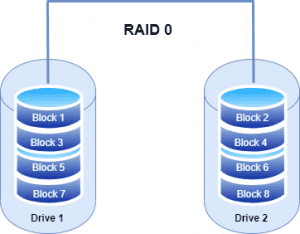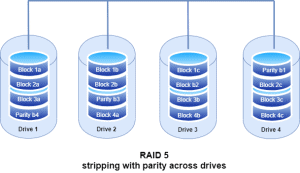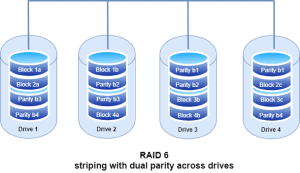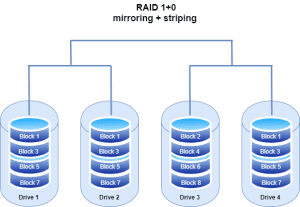1. 概述
在现代 IT 系统中,磁盘存储的性能与可靠性对任何组织都至关重要。RAID(Redundant Array of Independent Disks,独立磁盘冗余阵列)是一种用于提升系统性能和增强数据可靠性的关键技术。
本文将从 RAID 的基本概念出发,介绍其常见级别(RAID Level)及其特点,帮助你理解在不同场景下应如何选择合适的 RAID 配置。
2. 什么是 RAID?
RAID 是一种将两个或多个磁盘驱动器并行工作的技术。这些磁盘可以是传统的机械硬盘(HDD)或固态硬盘(SSD)。RAID 通过不同的数据分布策略,提供不同程度的性能优化和容错能力。
需要注意的是,RAID 级别并没有统一的国际标准。不同组织会根据数据的重要性、系统需求和预算来选择适合的 RAID 级别。
3. RAID 级别详解
RAID 按照其数据分布和容错机制被划分为多个级别。以下是一些常见且重要的 RAID 级别:
3.1 RAID 0 – 条带化(Striping)

RAID 0 将数据分割为多个块,并同时写入多个磁盘。这种并行操作显著提升了 I/O 性能,且磁盘空间被完全利用,实现起来也较为简单。
✅ 优点:
- 高读写性能
- 磁盘利用率 100%
❌ 缺点:
- 无容错能力。只要其中一块磁盘损坏,整个阵列的数据都会丢失。
⚠️ 适用场景:适用于对性能要求高,但对数据安全性要求不高的环境,如临时缓存、测试环境等。
3.2 RAID 1 – 镜像(Mirroring)

RAID 1 通过将数据完全复制到另一个磁盘上来实现数据冗余,也称为镜像技术。
✅ 优点:
- 极高的读取性能(可以从任意一个磁盘读取)
- 支持单盘故障容错
❌ 缺点:
- 存储成本翻倍(因为数据被复制)
- 写入性能略低于 RAID 0
⚠️ 适用场景:适用于对数据安全性要求极高的系统,如数据库主服务器、关键业务系统等。
3.3 RAID 5 – 条带化 + 奇偶校验(Striping with Parity)

RAID 5 是目前最常用的一种 RAID 级别。它至少需要三块磁盘,最多可支持 16 块磁盘。
数据以条带方式分布在多个磁盘上,同时计算奇偶校验信息(通过 XOR 运算),并将奇偶校验信息分散存储在各个磁盘中。
✅ 优点:
- 支持单盘故障容错
- 磁盘利用率较高(N-1)
- 读取性能良好
❌ 缺点:
- 写入性能受限(因为需要计算奇偶校验)
- 在重建磁盘时 I/O 负载较高
⚠️ 适用场景:适用于读多写少的场景,如文件服务器、Web 服务器等。
3.4 RAID 6 – 双重奇偶校验(Striping with Double Parity)

RAID 6 是 RAID 5 的增强版本。它在 RAID 5 的基础上引入了第二个奇偶校验块,因此至少需要四块磁盘。
✅ 优点:
- 支持双盘故障容错
- 数据安全性更高
- 存储效率优于 RAID 10
❌ 缺点:
- 写入性能低于 RAID 5(因为需要两次奇偶校验计算)
- 成本略高(需要更多磁盘)
⚠️ 适用场景:适用于对数据安全要求极高、磁盘数量较多的大型存储系统。
3.5 RAID 10 – RAID 1 + RAID 0 的组合

RAID 10 是 RAID 1 和 RAID 0 的组合。它先对磁盘进行镜像(RAID 1),再对镜像组进行条带化(RAID 0)。
✅ 优点:
- 极高的读写性能
- 支持多盘故障(每组镜像最多坏一块)
❌ 缺点:
- 成本高(需要至少 4 块磁盘)
- 磁盘利用率仅为 50%
⚠️ 适用场景:适用于对性能和可靠性都有极高要求的场景,如数据库主服务器、高并发交易系统等。
4. RAID 与传统数据备份的区别
RAID 并不能替代传统的数据备份机制。虽然 RAID 能提供磁盘级别的容错能力(如 RAID 1 支持单盘故障,RAID 6 支持双盘故障),但它无法防止以下情况导致的数据丢失:
- 文件误删
- 系统误操作
- 硬件故障导致多盘同时损坏(尤其是 RAID 0)
- 病毒、恶意攻击等逻辑错误
因此,即使使用了 RAID,也应定期进行数据备份,并将备份存储在异地或离线环境中,以确保数据安全。
5. 总结
RAID 是提升系统性能和数据可靠性的关键技术。不同 RAID 级别各有优劣,适用于不同的业务场景。
- RAID 0:追求极致性能,不考虑容错
- RAID 1:高可靠性,适合关键数据
- RAID 5:平衡性能与可靠性,适用于多数场景
- RAID 6:增强容错,适合大规模存储
- RAID 10:兼顾性能与可靠性,适合关键业务系统
⚠️ 踩坑提醒:不要误以为 RAID 可以替代备份。RAID 只能防止磁盘物理故障,而不能防止逻辑错误或人为误操作。
选择合适的 RAID 配置,结合完善的数据备份策略,才能真正保障系统的高可用性与数据完整性。